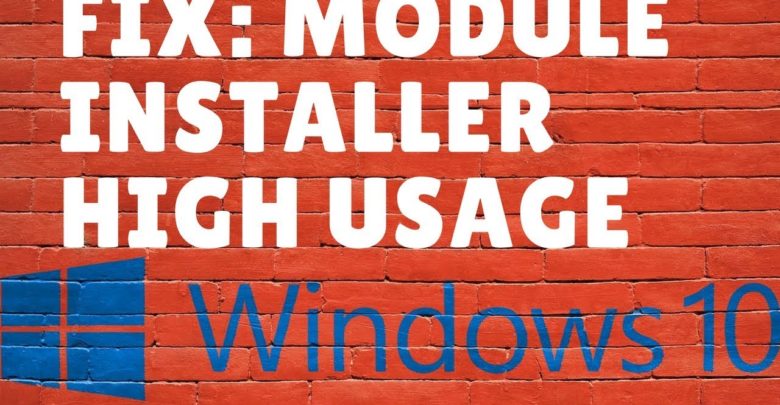How to fix Windows Modules Installer Worker High CPU In Windows 10

Windows Modules Installer Worker is a common error in Windows machine, especially on computers running Windows 10. You will encounter this error when Windows Modules Installer Worker tool becomes nonresponsive in task manager and causes high CPU use.
The good news is that you can easily fix this error. Explore different methods to resolve this error below. If one method doesn’t work for you, try another. We have tested all these methods. They are safe and work for 99% users having this glitch on their PC.
What is Windows Modules Installer Worker?
Windows Modules Installer Worker is a tool built into Windows OS to check for updates. Your operating system updates itself and fixes bugs using this tool.
To do its job, Windows Modules Installer Worker high disk usage process runs in the background. Sometimes, it may become unresponsive when checking for updates and fixing bugs. As a result, your system may become utterly slow or completely unresponsive.
If you are seeing Windows Modules Installer Worker problem, we got it covered here. Below, you will learn how to fix the problem and keep your computer running smoothly without any further interruptions.
How to Fix Windows Modules Installer Worker High Disk Usage Error
It’s easy to solve this common error as long as you can read and follow instructions.
We have tested various methods to fix this error. Below are the methods that ACTUALLY work.
Method 1: Change Automatic Windows Updates to Manual Updates
As explained earlier, Windows Modules Installer Worker error often pop up when you have a problem with automatic Windows updates. It’s common among Windows 10 users but you can also encounter it on Windows 7/8.
One of the easiest methods to solve high CPU usage Windows is to turn updates to ‘manual’. With that done, the Windows Update process doesn’t run in the background. As a result, it won’t become unresponsive and eat system resources any more.
Follow the simple steps below to resolve this glitch. You will learn how to disable Windows Modules Installer Worker.
NOTE: If this method doesn’t work for you, use method 2 where we teach you how to TIWORKER.EXE.
Step 1
Press Windows button + R on the keyboard. Now type ‘services.msc’ and click OK.
Step 2
A new window will appear. Now search for ‘Windows module installer’ after clicking the search icon in the right-top corner of the window.
Step 3
Once you have found the Windows Module Installer, double-click on it. You will see a new window. Locate ‘Startup Type’ (as seen in the picture below). Change it from ‘automatic’ to ‘manual’. Click OK at the bottom of the window.
Step 4
Now go back to services.msc window. Search for ‘Windows Update’ this time and set it to ‘manual’. You simply have to double-click and change the startup type as you did in the previous step.

Step 5
Now open control panel and find Windows Update.
Step 6
Open Windows Update and go to ‘change settings’. There you should be able to change the way Windows updates itself. Choose ‘check for update but let me choose whether to download and install them’. Click OK and close all the windows.
Step 7
This is the final step. Simply reboot your computer. Once your computer restarts, you will have ‘manual’ update activated. Hopefully, you won’t see ‘Windows modules installer’ message ever again.
Make sure you check Windows for updates manually at regular intervals. Your computer won’t update itself automatically. Missing on important updates could make your OS unstable and cause various performance glitches.
Method 2: Fix TIWORKER.EXE
Sometimes, your task manager indicates high CPU usage even when you have changed ‘automatic’ updates to ‘manual’ updates.
In such cases, the problem is due to tiworker.exe. This executable file is also connected to Windows Update.
When tiworker.exe is causing high CPU use, you can simply fix it by following the steps below.
Step 1
Windows 10 users should press Windows Home button and search for ‘Troubleshooting’. Click it to go to dedicated troubleshooting page.
For users on older version of Windows, simply search Troubleshooting in control panel.
See the picture below for further explanation.
Step 2
In the new window, look at the left side. You will some options there. Locate “View All” and click it. See the picture below if you can’t find it.
Step 3
After you go to View All, you should be able to locate ‘System Maintenance’. Click on it and it will start detecting issues with your system.
It will take a minute or so. Once done, you should reboot your computer.
Hopefully, this will solve your problem. If you are seeing it despite following instructions above, go to the next method.
Method 3: Perform a Clean Boot
The last step you can take to solve your problem is to perform a clean boot. You will be doing this through Microsoft Configurations tool found in every Windows system.
This tool lets you find the unwanted and temporary files on your system. By deleting them, you can release some amount of space. Moreover, it will free up your CPU from unwanted services and processes.
Consequently, you will experience reduced CPU use.
Step 1
Click on Windows button and search for msconfig.exe. Once found, open it.
Step 2
Once you see the MSConfig window, simply select normal startup. Press OK.

Now go ahead and restart your computer by following the on-screen prompts.
After restart, you won’t see high CPU use error. You can open as many apps you want without worrying about your computer getting terribly slow.
These are the most common methods to fix the issue of Windows Modules Installer Worker. I hope one of the methods has solved your problems. If not, upgrade your system hardware.
The only reason it is still giving you this error is because it doesn’t meet the hardware configurations to run all your apps.












